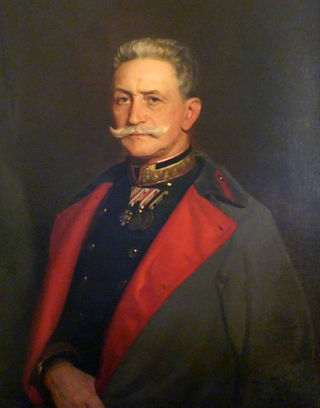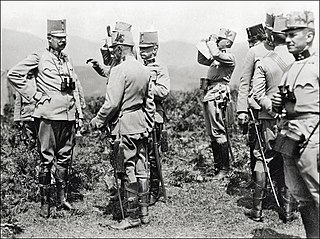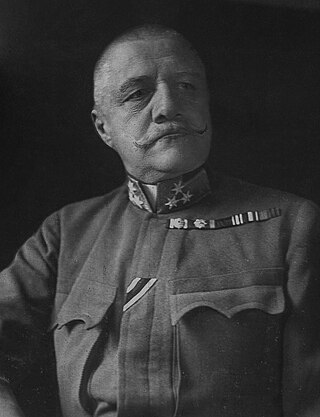
Franz Xaver Josef Conrad von Hötzendorf, sometimes anglicised as Hoetzendorf, was an Austrian general who played a central role in World War I. He served as K.u.k. Feldmarschall and Chief of the General Staff of the military of the Austro-Hungarian Army and Navy from 1906 to 1917. He was in charge during the July Crisis of 1914 that caused World War I.

Svetozar Boroević von Bojna was an Austro-Hungarian field marshal of Croatian Serb descent who was described as one of the finest defensive strategists of the First World War. He commanded Austro-Hungarian forces in the Isonzo front, for which he was nicknamed the "Lion of Isonzo".

The Second Battle of the Piave River, fought between 15 and 23 June 1918, was a decisive victory for the Italian Army against the Austro-Hungarian Empire during World War I, as Italy was part of the Allied Forces, while Austria-Hungary was part of the Central Powers. Though the battle proved to be a decisive blow to the Austro-Hungarian Empire and by extension the Central Powers, its full significance was not initially appreciated in Italy. Yet Erich Ludendorff, on hearing the news, is reported to have said he 'had the sensation of defeat for the first time'. It would later become clear that the battle was in fact the beginning of the end of the Austro-Hungarian Empire.

The Military Order of Maria Theresa was the highest military honour of the Habsburg monarchy, Austrian Empire and Austro-Hungarian Empire.

The First Battle of the Isonzo was fought between the armies of Italy and Austria-Hungary on the northeastern Italian Front in World War I, between 23 June and 7 July 1915.

The Third Battle of the Isonzo was fought from 18 October through 4 November 1915 between the armies of Italy and Austria-Hungary.

The Serbian campaign was a series of military expeditions launched in 1914 and 1915 by the Central Powers against the Kingdom of Serbia during the First World War.

Viktor Graf von Scheuchenstuel was a colonel general in the Austro-Hungarian Army. He was a general staff officer and division commander until World War I broke out. During World War I he was a Corps and Army commander serving in Serbia, Albania and Italy. During World War I he was promoted to Graf in the Austrian nobility. Following the end of World War I and the end of the Austro-Hungarian Empire, Scheuchenstuel retired from the military. He died in Vienna.

The 42nd Home Guard Infantry Division, nicknamed the Devil's Division was an infantry division of the Royal Croatian Home Guard within the Austro-Hungarian Army which was active in World War I.

Liborius Ritter von Frank was an Austro-Hungarian general in World War I. He commanded the Austro-Hungarian Fifth Army in 1914 at the start of the war, and fought at the Battle of Cer, Battle of Drina and Battle of Kolubara. He was replaced by General Karl Tersztyánszky von Nádas after the failure of the first Serbian Campaign, the enormous casualties suffered by his army reduced to about 40% of its strength and the disbandment of the Balkanstreitkräfte.

The Austro-Hungarian Armed Forces occupied Serbia from late 1915 until the end of World War I. Austria-Hungary's declaration of war against Serbia on 28 July 1914 marked the beginning of the war. After three unsuccessful Austro-Hungarian offensives between August and December 1914, a combined Austro-Hungarian and German offensive breached the Serbian front from the north and west in October 1915, while Bulgaria attacked from the east. By January 1916, all of Serbia had been occupied by the Central Powers.

The leaders of the Central Powers of World War I were the political or military figures who commanded or supported the Central Powers.

Wenzel Freiherr von Wurm was a Colonel General in the Austro-Hungarian Army.
Chetniks in World War I were members of auxiliary units used by the Royal Serbian Army for special operations against invading Austro-Hungarian, Bulgarian and German forces.
The 2nd Army, later designated East Army, was a field army-level command of Austro-Hungarian Army that was active during World War I. It was initially formed to take part in the Balkans Campaign before being transferred to the Eastern Front. In the final stages of the war, the army was evacuated from Ukraine before demobilizing in November 1918.
The 3rd Army was a field army-level command within the ground forces of Austria-Hungary during World War I. It was primarily active on the Eastern Front against the Russian Empire and in the Balkans against Serbia and Montenegro. Later on, the 3rd Army took part in some fighting on the Italian Front before returning to the eastern theater by 1917 to repulse the Kerensky Offensive. Its remaining units were merged with the 7th Army in January 1918.
The Serbian Campaign of 1914 was a significant military operation during World War I. It marked the first major confrontation between the Central Powers, primarily Austro-Hungary, and the Allied Powers, led by the Kingdom of Serbia. The campaign started on 28 July 1914, when Austria-Hungary declared war on Serbia and bombarded Belgrade. On 12 August, the Austro-Hungarian forces, led by General Oskar Potiorek, launched their first offensive into Serbia.

The Balkanstreitkräfte, also known as the Balkan Army, was the force raised by Austria-Hungary for its offensive action against Serbia in August 1914, at the start of World War I.

Ludwig Goiginger was an Austro-Hungarian Lieutenant Field Marshal who notably served in World War I.

Colonel General Adolf Freiherr von Rhemen zu Barensfeld, sometimes referred to as Baron Rhemen, was a German senior officer in the Austro-Hungarian Army, known for his commanding roles during the First World War.
This page is based on this
Wikipedia article Text is available under the
CC BY-SA 4.0 license; additional terms may apply.
Images, videos and audio are available under their respective licenses.














